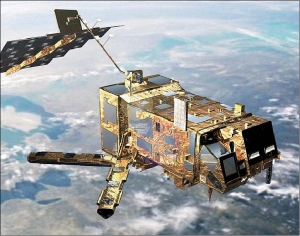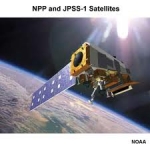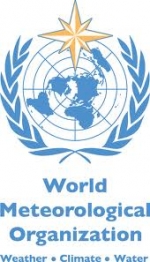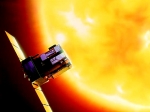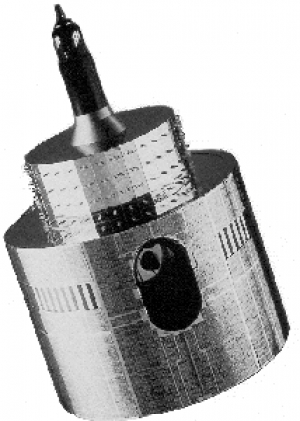Displaying items by tag: meteorology
MetOp (Meteorological Operational Satellite Program of Europe)
MetOp-A is Europe's first polar-orbiting (LEO) satellite dedicated to operational meteorology. The MetOp program was originally planned as a much larger satellite concept, called POEM (Polar-Orbit Earth-Observation Mission), a successor mission series to ERS-1/2 on the Columbus Polar Platform (PPF design).
However, this idea was abandoned at the ESA Ministerial Council in Granada, Spain, in 1992. Instead, Envisat and MetOp were born. Full approval of the EPS (EUMETSAT Polar System) program was granted in September 1998. The MetOp program is planned as a series of three satellites to be launched sequentially over an observational period of 14 years, starting in 2006 with MetOp-A (2010, 2014), it represents the space segment of EPS. 1) 2)
Japan Meteorological Agency (JMA)
The Japan Meteorological Agency (JMA), is an agency of the Ministry of Land, Infrastructure, Transport and Tourism.
JMA is charged with gathering and providing results for the public in Japan, that are obtained from data based on daily scientific observation and research into natural phenomena in the fields of meteorology, hydrology, seismology and volcanology, among other related scientific fields. Its headquarters is located in Chiyoda, Tokyo, Japan.
EARS System
the EARS system is a Eumetsat project for data retransmission. 'EARS' means 'Eumetsat Advanced Retransmission Service'.
The object of the EARS system is to provide the European meteorological community with sounder data covering data-sparse areas, within 30 minutes of the instrument observations.
EARS comprises three separate polar satellite instrument data services:
- the existing EARS-ATOVS;
- the EARS-AVHRR;
- and the pilot EARS-ASCAT.
Each of the EARS services retransmits observations from an instrument, or an instrument group, and aims to provide a homogeneous service across the NOAA and Metop polar orbiting satellite platforms.
System Overview:
| satellite -> | NOAA KLM | NOAA NN' | METOP |
| EARS-ATOVS | HIRS/3 AMSU-A AMSU-B |
HIRS/4 AMSU-A MHS |
HIRS/4 AMSU-A MHS |
|---|---|---|---|
| EARS-AVHRR | AVHRR/3 | AVHRR/3 | AVHRR/3 |
| EARS-ASCAT | - | - | ASCAT |
Suomi NPP
The Suomi National Polar-orbiting Partnership, or Suomi NPP, is a weather satellite operated by the United States National Oceanic and Atmospheric Administration.
Originally intended as a pathfinder for the NPOESS programme, which was to have replaced NOAA's Polar Operational Environmental Satellites and the US Air Force's Defense Meteorological Satellite Program, Suomi was launched in 2011 after the cancellation of NPOESS to serve as a gapfiller between the POES satellites and the Joint Polar Satellite System which will replace them. Its instruments provide climate measurements that continue prior observations by NASA's Earth Observing System.
it was previously known as the National Polar-orbiting Operational Environmental Satellite System Preparatory Project (NPP) and NPP-Bridge.
Spaceflight Meteorology Group (SMG)
The Spaceflight Meteorology Group (SMG) is a U.S. weather forecasting unit staffed by the National Weather Service (NWS) for the National Aeronautics and Space Administration (NASA) which provides pertinent information on the current and expected state of the atmosphere during human spaceflight operations. It is located at the Johnson Space Center in Houston, Texas.
Meteorological information for the broader space program is provided by the 45th Space Wing's 45th Weather Squadron of the U.S. Air Force.
World Meteorological Organization (WMO)
The World Meteorological Organization (WMO) is an intergovernmental organization with a membership of 189 Member States and Territories.
It originated from the International Meteorological Organization (IMO), which was founded in 1873. Established in 1950, WMO became the specialised agency of the United Nations for meteorology (weather and climate), operational hydrology and related geophysical sciences. It has its headquarters in Geneva, Switzerland, and is a member of the United Nations Development Group.
EPS-SG (programme)
EPS is a programme of Earth observation for Meteorology and weather forecast. The satellite is called METOP. EPS/METOP is managed by the European organisation EUMETSAT. Placed on a polar orbit, the satellite sends picture of the whole Earth.
EPS-SG is the Second Generation of this programme. (respectively the satellite is METOP-SG)
Activities are on-going (Aug. 2012) for the definition of the follow-on EUMETSAT Polar System, to replace the current satellite system in the 2020 timeframe and contribute to the Joint Polar System to be set up with NOAA. Through consultation with users and application experts, requirements have been defined for a range of candidate missions mainly in support of operational meteorology and climate monitoring. A number of on-board instruments, satellite platforms and ground support infrastructure are under study in coordination with ESA, NOAA, DLR and CNES. The satellites will fly, like Metop, in a sun synchronous, low earth orbit at 817 km altitude and 09:30 local time of the descending node, providing observations over the full globe with revisit times of 12 to 24 hours, depending on instrument. Feasibility studies are on-going with the main objective to define the baseline configuration for subsequent detailed design, development and operation programmes to be proposed and coordinated within the involved organisations. Started in 2005 under the name of Post-EPS, the activities will enter in 2012 the design and development phases under a new programme: EPS Second Generation (EPS-SG).
SOHO (mission & spacecraft)
The Solar and Heliospheric Observatory (SOHO) mission purpose is to study the Sun from a point of gravitational balance.
The SOHO spacecraft has been built by a European industrial consortium led by Matra Marconi Space (now Astrium) that was launched on a Lockheed MartinAtlas IIAS launch vehicle on December 2, 1995 to study the Sun, and has discovered over 2100 comets. It began normal operations in May 1996.
It is a joint project of international cooperation between the European Space Agency (ESA) and NASA. Originally planned as a two-year mission,SOHO currently continues to operate after over fifteen years in space. In October 2009, a mission extension lasting until December 2012 was approved.
In addition to its scientific mission, it is currently the main source of near-real time solar data for space weather prediction. Along with the GGS Wind and Advanced Composition Explorer (ACE),SOHO is one of three spacecraft currently in the vicinity of the Earth-Sun L1 point, a point of gravitational balance located approximately 0.99 astronomical unit (AU)s from the Sun and 0.01 AU from the Earth. In addition to its scientific contributions, SOHO is distinguished by being the first three-axis-stabilized spacecraft to use its reaction wheels as a kind of virtual gyroscope; the technique was adopted after an on-board emergency in 1998 that nearly resulted in the loss of the spacecraft.
Meteosat
The Meteosat series of satellites are geostationary meteorological satellites operated by the Euopean organisation EUMETSAT.
EUMETSAT
The European Organisation for the Exploitation of Meteorological Satellites (EUMETSAT) is an intergovernmental organisation created through an international convention agreed by a current total of 30 European Member States.
EUMETSAT's primary objective is to establish, maintain and exploit European systems of operational meteorological satellites. EUMETSAT is responsible for the launch and operation of the satellites and for delivering satellite data to end-users as well as contributing to the operational monitoring of climate and the detection of global climate changes.
The activities of EUMETSAT contribute to a global meteorological satellite observing system coordinated with other space-faring nations.
Satellite observations are an essential input to numerical weather prediction systems and also assist the human forecaster in the diagnosis of potentially hazardous weather developments. Of growing importance is the capacity of weather satellites to gather long-term measurements from space in support of climate change studies.
EUMETSAT is not part of the European Union, but became a signatory to the International Charter on Space and Major Disasters in 2012, thus providing for the global charitable use of its space assets.[1]
- public organisation
- Europe
- mission operations
- satellite operator
- meteorology
- Copernicus (EO program)
- Meteosat Third Generation
- Meteosat
- Meteosat Second Generation
- MTG
- MSG
- MTP
- Meteosat Transition Phase
- METOP
- METOP SG
- Sentinel 1
- Sentinel 2 satellite
- Sentinel 2
- Sentinel 3
- Sentinel 4
- sentinel 5P
- sentinel 5
- Sentinel 6
- JasonCS
- Jason 2
- Jason 3
- EPS
- EPS_SG
- NOAA

